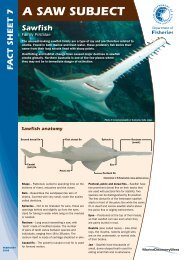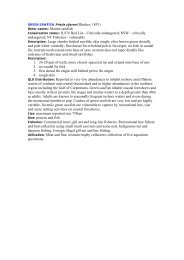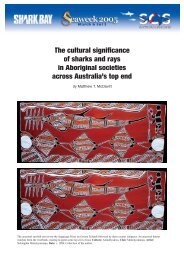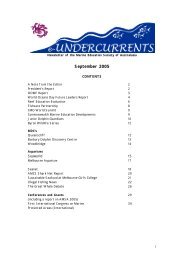Determining feasibility of acoustic tag attachment and documenting ...
Determining feasibility of acoustic tag attachment and documenting ...
Determining feasibility of acoustic tag attachment and documenting ...
Create successful ePaper yourself
Turn your PDF publications into a flip-book with our unique Google optimized e-Paper software.
DepthA small diurnal shift in preferred water depth was apparent. On average, during theday the sawfish was in water twice as deep as during the night. This is most likelyattributed to the lack <strong>of</strong> water on the flats at low tide <strong>and</strong> the sawfish being forced intothe channel adjacent to the flats during the day. The tidal cycle would influence theforaging area made available to the sawfish for feeding.Comparing the tidal cycle data against the data from TDR <strong>tag</strong> it appears that theremight be a diurnal influence on the sawfish’s preference for water depth. Therelationship was significant for the sawfish’s preference for deeper water during theday <strong>and</strong> shallower water during the night. Further investigations are required to testthese preliminary findings. Despite these observations it appears that this sawfishdisplayed no inhibitions in moving into shallow water despite its large size (355 mmT L ).Management issuesThe preference for shallow water shown by the sawfish in this study <strong>and</strong> the fact thatit moved parallel to the shoreline suggests that sawfish may occupy a relatively smallarea <strong>of</strong> available habitat that is concentrated in a narrow strip <strong>of</strong> water adjacent to theshoreline, at least during feeding. These data are supported by studies on the smalltooth sawfish (P. perotetti) in North America (Simpfendorfer 2000; SimpfendorferPers. Comm 2003) where sawfish have been recorded along the shallow inshoreregions <strong>of</strong> the coastline. However, P zijsron have also been recorded in water depthgreater than 30 metres (Peverell & Gribble 2003) along the east coast <strong>of</strong> Queensl<strong>and</strong>.Pristis zijsron have been identified as a bycatch species <strong>of</strong> concern in the GoC inshoregill net fishery (Roel<strong>of</strong>s 2003 <strong>and</strong> Peverell in press). The reason for concern is thatsawfish are extremely vulnerable to capture because their toothed rostrum is easilyentangled in fishing net.Commercial inshore gillnet fishers in the GoC target species such as barramundi,queenfish, blue salmon, king salmon <strong>and</strong> sharks <strong>and</strong> use up to 600 m <strong>of</strong> 165.5 to15










